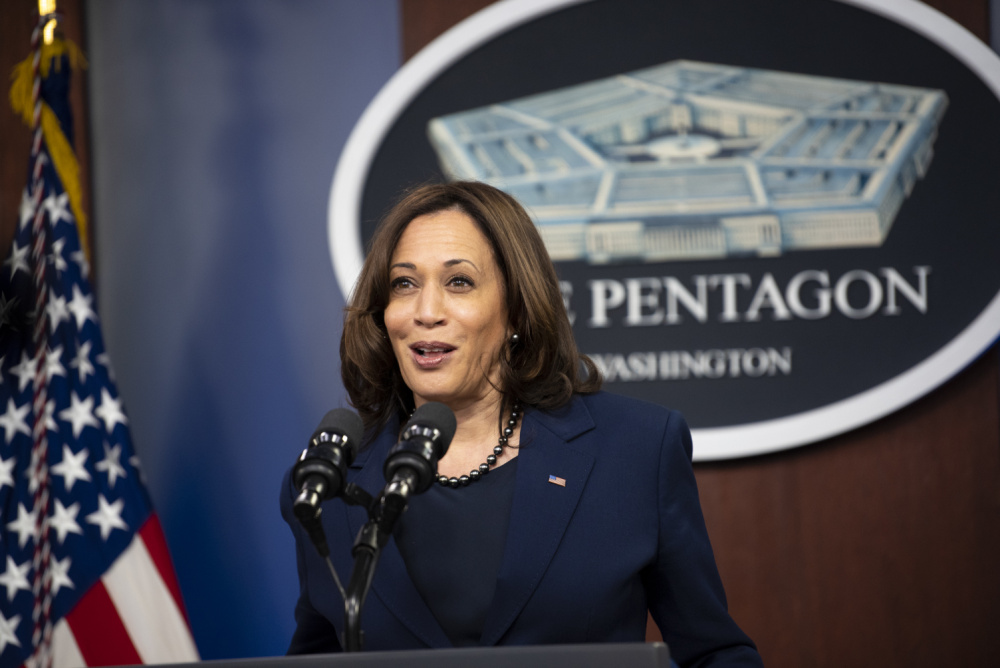The number of sailors who deserted the Navy more than doubled from 2019 to 2021, highlighting the lack of options contract-bound sailors face when they’re desperate to leave. May 18, 2022 / Melissa Chan / NBC News - The number of sailors who deserted the Navy more than doubled from 2019 to 2021, while desertions in other military branches dropped or stayed flat, pointing to a potential Navy-wide mental health crisis amid a spate of recent suicides, according to experts and federal statistics obtained by NBC News.
May 18, 2022 / Melissa Chan / NBC News - The number of sailors who deserted the Navy more than doubled from 2019 to 2021, while desertions in other military branches dropped or stayed flat, pointing to a potential Navy-wide mental health crisis amid a spate of recent suicides, according to experts and federal statistics obtained by NBC News.
Among a fleet of more than 342,000 active sailors, there were 157 new Navy deserters in 2021, compared with 63 in 2019 and 98 in 2020, Navy data shows. The total number of deserters who were still at large in 2021 grew to 166 from 119 in 2019. Most of them were 25 and younger.
“That’s staggering,” said Benjamin Gold, a defense attorney for U.S. service members.
In the wake of several suicides among sailors assigned to the warship the USS George Washington, the new desertion figures highlight the lack of options for sailors when they’re desperate to leave the military but are bound to multiyear contracts that many of them signed just out of high school.
Military law experts said the nearly unbreakable contracts — which can require up to six years of active duty — leave sailors with extreme alternatives: die by suicide or flee and face harsh consequences, including spending years behind bars as patriots-turned-pariahs.
“They feel trapped,” said Lenore Yarger, a resource counselor with the GI Rights Hotline, a nonprofit nongovernmental group that specializes in military discharges.
The National Network Opposing the Militarization of Youth (NNOMY)
NNOMY
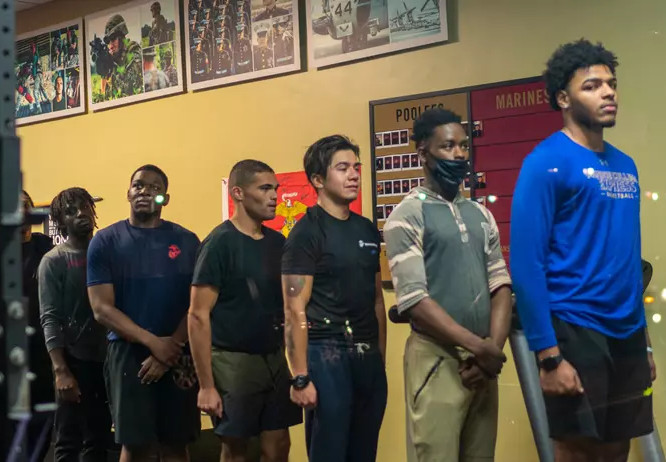 May 16, 2022 / Liz Walters / Common Dreams -This past January, student loan company Navient was made to cancel $1.7 billion in federal student debt in a federal settlement judged by Attorney General Maura Healey. The settlement, which also required Navient to distribute $95 million in restitution to approximately 350,000 federal loan borrowers, came after a long fight against the company's predatory lending practices, which promised to help students in need of tuition assistance, and instead steered them towards repayment plans that piled on unnecessary interest. Navient also participated in risky subprime lending without consideration for borrowers and their families, leaving hundreds of thousands of students in crippling debt that the company knew they would not be able to pay back. These shady practices have been going on for at least two decades with little government intervention. The settlement provided loan forgiveness for students who had borrowed between 2002 and 2010. During this time period, Navient, now privatized, was still known as Sallie Mae, an entity created by Congress to service federal loans. As Massachusetts Senator Elizabeth Warren put it: "Navient cheated students who borrowed money to pursue their dreams and allowed them to be crushed by avoidable debt, all while the U.S. Department of Education turned a blind eye."
May 16, 2022 / Liz Walters / Common Dreams -This past January, student loan company Navient was made to cancel $1.7 billion in federal student debt in a federal settlement judged by Attorney General Maura Healey. The settlement, which also required Navient to distribute $95 million in restitution to approximately 350,000 federal loan borrowers, came after a long fight against the company's predatory lending practices, which promised to help students in need of tuition assistance, and instead steered them towards repayment plans that piled on unnecessary interest. Navient also participated in risky subprime lending without consideration for borrowers and their families, leaving hundreds of thousands of students in crippling debt that the company knew they would not be able to pay back. These shady practices have been going on for at least two decades with little government intervention. The settlement provided loan forgiveness for students who had borrowed between 2002 and 2010. During this time period, Navient, now privatized, was still known as Sallie Mae, an entity created by Congress to service federal loans. As Massachusetts Senator Elizabeth Warren put it: "Navient cheated students who borrowed money to pursue their dreams and allowed them to be crushed by avoidable debt, all while the U.S. Department of Education turned a blind eye."
With pandemic restrictions easing, military recruiters are returning to high school campuses while anti-recruitment efforts struggle
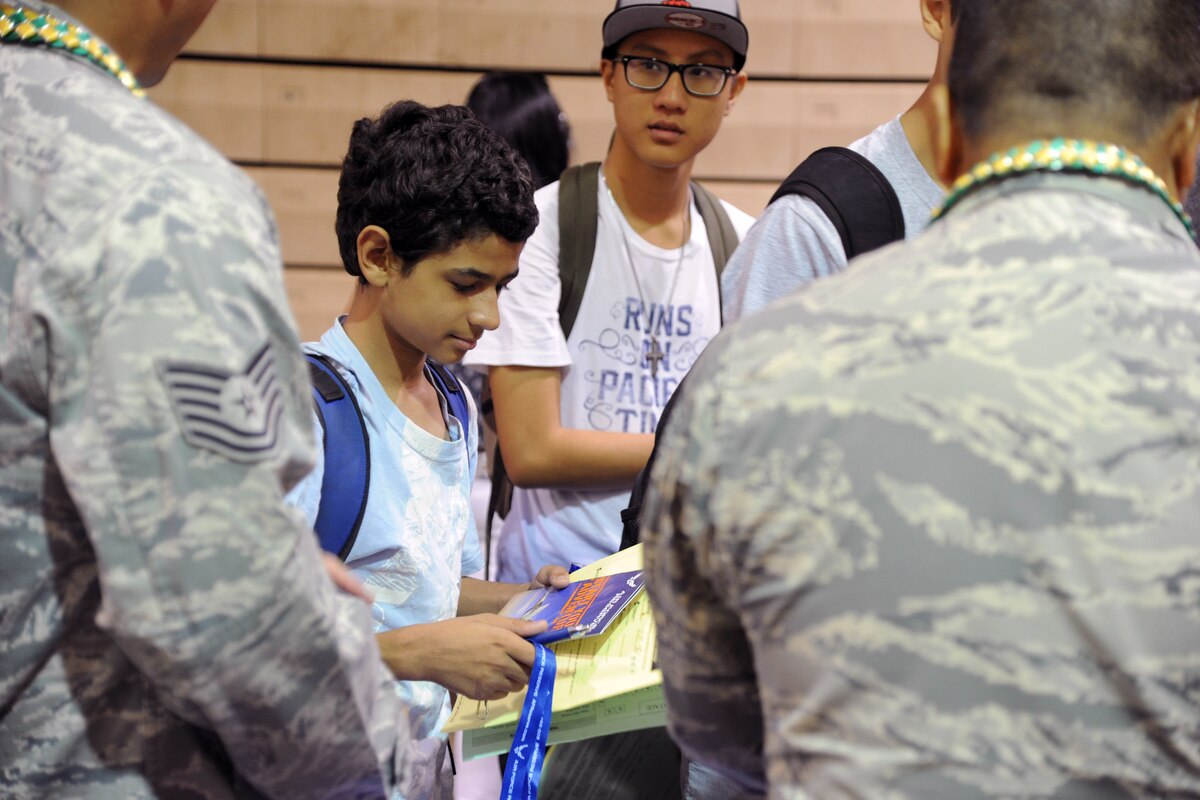 April 18th, 2022 / Roberto Camacho / Prism - The U.S. military utilizes a number of different recruitment methods to garner new enlistments, but their target audience has consistently remained the same: high schoolers, particularly young men from low-income and rural areas. Eighteen is the youngest age one can join the military without parental permission, but the armed forces still regularly market military propaganda in schools. Although the military does enjoy support within the public system, a grassroots movement of students, teachers, parents, and organizations has led efforts to reduce military recruitment presence and activities on high school campuses.
April 18th, 2022 / Roberto Camacho / Prism - The U.S. military utilizes a number of different recruitment methods to garner new enlistments, but their target audience has consistently remained the same: high schoolers, particularly young men from low-income and rural areas. Eighteen is the youngest age one can join the military without parental permission, but the armed forces still regularly market military propaganda in schools. Although the military does enjoy support within the public system, a grassroots movement of students, teachers, parents, and organizations has led efforts to reduce military recruitment presence and activities on high school campuses.
“We face an uphill battle not only because of the prominence of militarism in our society but [also] because there has been a lack of foresight by progressive people who aren’t thinking about what can happen 10 years down the line,” said Rick Jahnkow, former program coordinator for the nonprofit Project on Youth & Non-Military Opportunities (Project YANO) and a current member of the organization’s board of trustees.
The U.S. military has been an all-volunteer service since the end of the draft and the Vietnam War in 1973, making aggressive recruitment efforts essential to maintaining its 1.3 million-member active-duty global military force. Military recruitment in public schools isn’t new, but the level of access the military has to students and their information has increased alarmingly over the past several decades. Notably, recruiters got a significant boost when then-President George W. Bush signed the “No Child Left Behind” Act into law in 2002—under Section 9528 of the act, schools can lose their federal funding if they fail to allow military recruiters the same level of access to students and their private information as they do to other recruiters from community colleges and universities.
Introduction
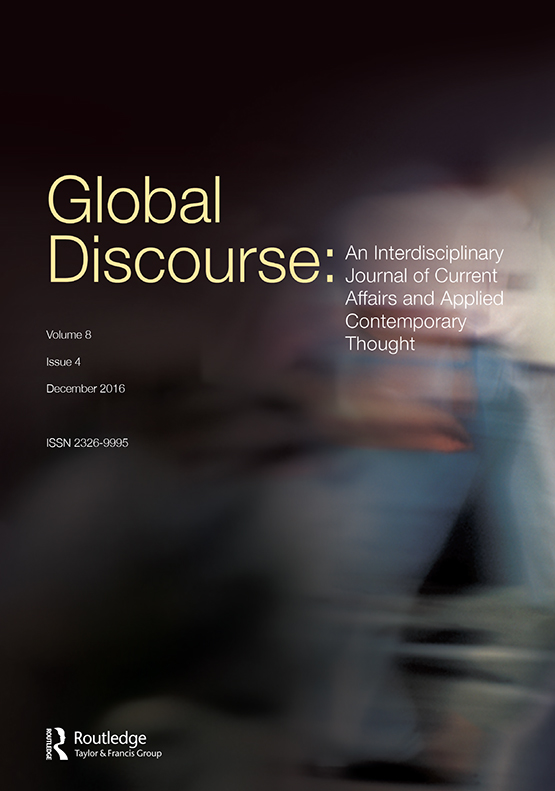 December 2016 / Matthew F. Rech / School of Geography, Politics and Sociology, Newcastle University - On 8 January 2002 in the US, George Bush Jr. signed into law an educational federal grant Act entitled ‘ No Child Left Behind ’ Though seemingly commendable at first glance, it being designed to improve academic attainment in disadvantaged state- funded schools (Zgonjanin 2006 ), a closer look at NCLBAs 670 pages revealed a provision that allowed military recruiters near unimpeded access to the personal information of enrolled students. On pain of forfeiture of federal funding, schools covered by the Act were required to release student names, addresses and telephone numbers to military recruiters. As Nava ( 2011 , 465) details, although
December 2016 / Matthew F. Rech / School of Geography, Politics and Sociology, Newcastle University - On 8 January 2002 in the US, George Bush Jr. signed into law an educational federal grant Act entitled ‘ No Child Left Behind ’ Though seemingly commendable at first glance, it being designed to improve academic attainment in disadvantaged state- funded schools (Zgonjanin 2006 ), a closer look at NCLBAs 670 pages revealed a provision that allowed military recruiters near unimpeded access to the personal information of enrolled students. On pain of forfeiture of federal funding, schools covered by the Act were required to release student names, addresses and telephone numbers to military recruiters. As Nava ( 2011 , 465) details, although
The provision gave parents the ability to ‘ opt-out ’ of releasing this information only if they first submit written notification to the school ... NCLBA ... does not provide any requirement, instruction, or mechanism to ensure that parents are aware of this.
The data-gathering proposition in the NCLBA, just as with the Pentagon ’ s Joint Advertising Marketing and Research database (Ferner 2006 ), is designed, at root, to streamline the solicitations of military recruiters. It focuses a military recruiting and retention budget, which reached $7.7 billion in 2008 (Vogel 2009 ), effectively according to gender, age, ethnicity and recreational interests, amongst other variables. Combined with the access granted to military recruiters in that of ‘ extra-curricular ’ junior reserve Officer Training Corps programmes, or the Armed Services Aptitude Battery test (a ‘ Careers ’ test offered by two thirds of all US schools) (Allison and Solnit 2007 ), it is clear that military recruiting is an important set of practices in what Harding and Kershner ( 2011 ) call a ‘ deeply embedded ’ culture of militarism in the US.
Though cultures of militarism differ markedly between places, their being a symptom of nationalisms, political, geographical and historical imaginaries, and a product of the state ’ s apparatus of persuasion, militarism in the UK is also bound to legislative efforts to promote a ‘ military ethos ’ in schools. In July 2012, for instance, shadow secretaries Stephen Twigg (education) and Jim Murphy (defence) wrote to the Telegraph to outline their vision for the future involvement of the British Armed Forces in schools (Twigg and Murphy 2012 ), opining that:
We are all incredibly proud of the work our Armed Forces do in keeping us safe at home and abroad. They are central to our national character, just as they are to our national security. The ethos and values of the Services can be significant not just on the battlefield but across our society.
Practically, Twigg and Murphy called for the widening of military Cadet schemes; new schools with service specialisms; the use of military advisors and reservists for physical education and other curricula; and a rebalancing of military involvement particularly as it is absent from the majority of state schools. The military might be best-placed to teach, they suggest, a ‘ service ethos ’ , a sense of ‘ responsibility and comradeship, and ‘ the value of hard work ’ and ‘ public service ’ .
Twigg and Murphy ’ s vision, has, since November 2012, variously become a reality with an expansion of the Cadets, a ‘ Troops to Teachers ’ programme, and Government support for fledgling military ‘ free-schools ’ and academies (Education.gov.uk 2014 ). Much like critics of NCLBA however, there are some who can ’ t help but see the connection between the Department for Education ’ s ‘ Ethos ’ programme and military recruitment. Indeed, as Sangster ( 2012 ) notes, along with the fact that the DfE does not provide an examination of what ‘ military ethos ’ actually means, or why schools are the best place to teach hierarchy, demand for obedience, or the value of the use of force, there are clear, and clearly troubling, links between the integration of military attitudes into the structure of national education policy and eventual enlistment (Armstrong 2007 ; Lutz and Bartlett 1995 ).

Opinion / 2/21/2022 / Gary Ghirardi - Under the federal Elementary and Secondary Education Act (ESEA), as amended by the Every Student Succeeds Act (ESSA), public high schools must give the names, addresses and telephone numbers of students to military recruiters, college/university recruiters and prospective employers if the recruiters request the information (ESSA, Title VIII, 8528). However, students or their parents have the right to instruct the school in writing that this information is not to be released.
But the parents are challenged in their ability to protect their children from all the ways that twenty-first century US American culture has to form their children’s political consciousness with its myriad conveyances of propaganda through a compliant militarized media, constant and expanding violent entertainment offerings, and an educational system that allows Pentagon programs inside public schools to instill a military ethos in their development.
In February of 2022, in the midst of a now endemic viral pandemic, the US appears to be on the cusp of a US / Russian conflict in Ukraine extending a long time civil war into a potentially lethal outcome for millions of people, and the world itself, if it morphs into a nuclear conflagration.
For two decades, the U.S. Army used a video game to reach new recruits. It’s finally shutting it down.
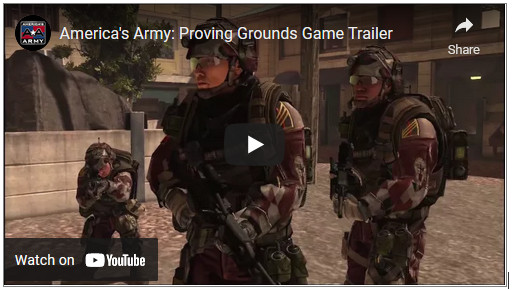 Matthew Gault | Vice - America’s Army: Proving Grounds, a game used as a recruitment tool by the United States government, is shutting down its servers on May 5 after existing in various iterations for 20 years. After that date, the game will be delisted on Steam and removed from the PSN store. Offline matches and private servers will work, but the game will no longer track stats or provide online matches.
Matthew Gault | Vice - America’s Army: Proving Grounds, a game used as a recruitment tool by the United States government, is shutting down its servers on May 5 after existing in various iterations for 20 years. After that date, the game will be delisted on Steam and removed from the PSN store. Offline matches and private servers will work, but the game will no longer track stats or provide online matches.
For 20 years, players have been able to download and play the Counter-Strike-esque game for free on PCs and consoles. It was a recruitment tool when no one else was using video games for recruitment, a free-to-play game well before that became common, and an attempt by the U.S. Army to reach a new generation of Americans.
“The free-to-play America’s Army PC Game represented the first large-scale use of game technology by the U.S. government as a platform for strategic communication and recruitment, and the first use of game technology in support of U.S. Army recruiting,” a forum post announcing the game’s shutdown said. “Three mainline titles and more than 20 million AA players later, the series’ original purpose continued. There have been over 30 million objectives completed, 180 million successful missions accomplished, 250 million teammates assisted, and many more in-game achievements attained in AA:PG alone.”
Subcategories
STEM (Science, Technology, Engineering and Mathematics) Article Count: 1
Opinion Article Count: 1
The NNOMY Opinion section is a new feature of our articles section. Writing on youth demilitarization issues is quite rare but we have discovered the beginning articles and notes being offered on this subject so we have decided to present them under an opinion category. The articles presented do not necessarily reflect the views of the NNOMY Steering Committee.
Civilian Marksmanship Program (CMP) Article Count: 1
NNOMY CAMPUS: Youth Counter-Recruitment and Demilitarization Workshops Online Article Count: 1
Activists Demilitarizing Our Public Schools
The NNOMY CAMPUS page is a resource for activists wishing to understand how to more effectively intervene in our public schools against the increasing influence of Pentagon programs to indoctrinate our youth for war. A series of webinars are being planned on different successful strategies to effect policy changes in school districts that better protect student privacy from military recruiters, to organize access to counter-recruit on campus, and to monitor the activities of military personnel on public school campuses. Topics are listed by series and subject. NNOMY webinar based workshops are a more effective method to instruct how to proceed with curbing the number of youth that make the choice to join into military service, or do so with a more informed picture of what this service will entail. This page will be updated periodically as additional webinars are conducted and new materials are produced to support these trainings. NNOMY will maintain these educational resources with the most up-to-date information and informed opinions as possible in order to keep the practice of national counter'recruitment efforts viable into the future.
| Available Webinars: |
Public Military Charter Schools Article Count: 1
Globalization & Militarization Article Count: 2
Military Presence in Our Schools Article Count: 10
Conservative Religious Influence Article Count: 2
 The warning, given to me 25 years ago, came at the moment Pat Robertson and other radio and televangelists began speaking about a new political religion that would direct its efforts at taking control of all institutions, including mainstream denominations and the government. Its stated goal was to use the United States to create a global, Christian empire. It was hard, at the time, to take such fantastic rhetoric seriously, especially given the buffoonish quality of those who expounded it. But Adams warned us against the blindness caused by intellectual snobbery. The Nazis, he said, were not going to return with swastikas and brown shirts. Their ideological inheritors had found a mask for fascism in the pages of the Bible. - Chris Hedges (From his article: The Christian Right and the Rise of American Fascism, 2011)
The warning, given to me 25 years ago, came at the moment Pat Robertson and other radio and televangelists began speaking about a new political religion that would direct its efforts at taking control of all institutions, including mainstream denominations and the government. Its stated goal was to use the United States to create a global, Christian empire. It was hard, at the time, to take such fantastic rhetoric seriously, especially given the buffoonish quality of those who expounded it. But Adams warned us against the blindness caused by intellectual snobbery. The Nazis, he said, were not going to return with swastikas and brown shirts. Their ideological inheritors had found a mask for fascism in the pages of the Bible. - Chris Hedges (From his article: The Christian Right and the Rise of American Fascism, 2011)
Revised 04/17/2016
Corporate Influence Article Count: 1
Young Marines Article Count: 1
Art & Cultural Activism Article Count: 1
The Militarization of U.S. Culture Article Count: 23
Though the United States of America shares with other nations in a history of modern state militarism, the past 78 years following its consolidation as a world military power after World War II has seen a shift away from previous democratic characterizations of the state. The last forty years, with the rise of the neo-conservative Reagan and Bush (2) administrations, began the abandonment of moral justifications for democracy building replaced by bellicose proclamations of the need and right to move towards a national project of global security by preemptive military force. Even with the return of eight years of the, so called, Liberal Obama administrations we saw the further erosion of long held human right protections with the suspension of habeas corpus and the increased usage of extra-judicial drone bombing killings of claimed combatants in multiple conflicts worldwide. Now with the Trump and Biden administrations, these programs have increased unbeknownst to the general public as the mainstream media silenced and normalized perpetual wars.
In the process of global military expansion, the US population has been subjected to an internal re-education to accept the role of the U.S. as consolidating its hegemonic rule internationally in the interest of liberal ideals of wealth creation and protectionism.
 The average citizen has slowly come to terms with stealthily increasing campaigns of militarization domestically in media offerings; from television, movies, militarized video games, and scripted news networks to reinforce the inevitability of a re-configured society as security state. The effect has begun a transformation of how, as citizens, we understand our roles and viability as workers and families in relation to this security state. This new order has brought with it a shrinking public common and an increasing privatization of publicly held infrastructure; libraries, health clinics, schools and the expectation of diminished social benefits for the poor and middle-class. The national borders are being militarized as are our domestic police forces in the name of Homeland Security but largely in the interest of business. The rate and expansion of research and development for security industries and the government agencies that fund them, now represent the major growth sector of the U.S.economy. Additionally, as the U.S. economy continually shifts from productive capital to financial capital as the engine of growth for wealth creation and development, the corporate culture has seen its fortunes rise politically and its power over the public sector grow relatively unchallenged by a confused citizenry who are watching their social security and jobs diminishing.
The average citizen has slowly come to terms with stealthily increasing campaigns of militarization domestically in media offerings; from television, movies, militarized video games, and scripted news networks to reinforce the inevitability of a re-configured society as security state. The effect has begun a transformation of how, as citizens, we understand our roles and viability as workers and families in relation to this security state. This new order has brought with it a shrinking public common and an increasing privatization of publicly held infrastructure; libraries, health clinics, schools and the expectation of diminished social benefits for the poor and middle-class. The national borders are being militarized as are our domestic police forces in the name of Homeland Security but largely in the interest of business. The rate and expansion of research and development for security industries and the government agencies that fund them, now represent the major growth sector of the U.S.economy. Additionally, as the U.S. economy continually shifts from productive capital to financial capital as the engine of growth for wealth creation and development, the corporate culture has seen its fortunes rise politically and its power over the public sector grow relatively unchallenged by a confused citizenry who are watching their social security and jobs diminishing.
 How increasing cultural militarization effects our common future will likely manifest in increased public dissatisfaction with political leadership and economic strictures. Social movements within the peace community, like NNOMY, will need to expand their role of addressing the dangers of militarists predating youth for military recruitment in school to giving more visibility to the additional dangers of the role of an influential militarized media, violent entertainment and play offerings effecting our youth in formation and a general increase and influence of the military complex in all aspects of our lives. We are confronted with a demand for a greater awareness of the inter-relationships of militarism in the entire landscape of domestic U.S. society. Where once we could ignore the impacts of U.S. military adventurisms abroad, we are now faced with the transformation of our domestic comfort zone with the impacts of militarism in our day to day lives where we are witnessing militarized police forces in all our cities.
How increasing cultural militarization effects our common future will likely manifest in increased public dissatisfaction with political leadership and economic strictures. Social movements within the peace community, like NNOMY, will need to expand their role of addressing the dangers of militarists predating youth for military recruitment in school to giving more visibility to the additional dangers of the role of an influential militarized media, violent entertainment and play offerings effecting our youth in formation and a general increase and influence of the military complex in all aspects of our lives. We are confronted with a demand for a greater awareness of the inter-relationships of militarism in the entire landscape of domestic U.S. society. Where once we could ignore the impacts of U.S. military adventurisms abroad, we are now faced with the transformation of our domestic comfort zone with the impacts of militarism in our day to day lives where we are witnessing militarized police forces in all our cities.
How this warning can be imparted in a meaningful way by a movement seeking to continue with the stated goals of counter-recruitment and public policy activism, and not loose itself in the process, will be the test for those activists, past and future, who take up the call to protect our youth from the cultural violence of militarism.
 The "militarization of US culture" category will be an archive of editorials and articles about the increasing dangers we face as a people from those who are invested in the business of war. This page will serve as a resource for the NNOMY community of activists and the movement they represent moving into the future. The arguments presented in this archive will offer important realizations for those who are receptive to NNOMY's message of protecting our youth, and thus our entire society, of the abuses militarism plays upon our hopes for a sustainable and truly democratic society.
The "militarization of US culture" category will be an archive of editorials and articles about the increasing dangers we face as a people from those who are invested in the business of war. This page will serve as a resource for the NNOMY community of activists and the movement they represent moving into the future. The arguments presented in this archive will offer important realizations for those who are receptive to NNOMY's message of protecting our youth, and thus our entire society, of the abuses militarism plays upon our hopes for a sustainable and truly democratic society.
NNOMY
Please consider becoming a supporter of The National Network Opposing the Militarization of Youth
And our work to demilitarize our schools and youth.
Donate Here
###
Revised / 11/04/2023 - GDG
Resources Article Count: 48
The Resources section covers the following topics:
Social media Campaign Resources Article Count: 42
NNOMYpeace has organized the following resources for our own staff of activists to promote our campaigns on different social media platforms. Many are formatted for Facebook, Instagram, and Twitter feeds.
We also welcome those activists inside our network of groups doing Truth in Recruitment and Counter-recruiting activism to utilize there resources for their own social media channels.
If you are not a group associated to NNOMYpeace, and would like to utilize these resources on your own channels, we encourage your groups to integrate to NNOMY on our National Directory of Youth Demilitarization Groups to help support the national community of youth demilitarization groups to know you and the scope of your activism. You can share your information to list your group by submitting an organizational form at the following LINK.
We have distributed the following graphics by campaign. Click on the categories below to see those that support different campaign themes by NNOMY
__________________________________________
Divest “Your Body” from the War Machine Article Count: 1
The Divest “Your Body” from the War Machine graphics are campaigning resources for social media for the Divest campaign that NNOMY is collaborating with CodePink. NNOMY focuses on asking youth to "Divest of their Bodies" from military service with the war machine. These are strictly to be utilized with counter-recruitment only and not with TIR.
Winning The Peace: A National High School Intervention Article Count: 2
These social media resources are to be utilized with the "Winning the Peace" campaign in cooperation with the palm cards developed by War Resisters League and the support website created for smart phones, "What Everyone Should Know Before Joining the Military / Lo que deberías saber entres de enrolarte en las Fuerzas Armadas (FF.AA.) ," to answer questions for youth about what military service really involves for them.
Know about Groups doing Youth Demilitarization Nationally Article Count: 1
These social media resources focus on groups nationally and regionally that take part in some form of youth demilitarization activism. That can include themes such as Truth in Recruitment or Counter-recruitment activism or participate in outreach to schools as veteral or antiwar speakers. Those using them should be cognizant of the limits that your location and context present before you decide to select the appropriate images and appeals for your use.
Misc. Social Media images Article Count: 1
The Misc. social media image resources category are designed around various appeals encompassing general counter-recruitment messages and antiwar themes. They should be utilized judiciously with attention paid to the moment and situation of which they are applied. Some of these may be themed along specific important dates in the peace calendar of on specific subject relating to militarization especially those themes that effect youth. Those found in this category are not specific to a campaign.
Social media Campaign Resources Article Count: 1
Back to School Against War & Militarism! Get the 2018-19 Back-to-school Kit for Counter-recruiting and School De-militarization Organizing from The National Network Opposing the Militarization of Youth and find out how you can help keep our youth safer and send a message to school officials and your government... military recruiters should be monitored in local high school and minor-aged youth deserve a balanced narrative on military service! Act Now to activate in your child's public school against Pentagon intrusions into our community youth.
Eliminate Selective Service for Everyone Article Count: 14
The "Eliminate Selective Service for Everyone" campaign category addresses the antiquated Selective Service system and the demand for its elimination. With the issue of women now being qualified for combat duties including fighting, the issue has been brought before the congress and senate of the United States to require women to register, like men, in the years when young adults are typically drafted into the services to fight wars if the draft needs to be re-initiated in the event of a national crisis where there are not sufficient troops to meet the troop requirement.
This campaign, "Eliminate Selective Service for Everyone," asks for the elimination of this demand based on it being a violation of basic and internationally recognized human rights protocols including the Universal Declaration of Human Rights.
Costs of War Article Count: 2
The "Costs of War" campaign category came from the Watson Institute for International Affairs website of Brown University in Providence, RI. This institute has made their research into the economic, social, political, and human costs of U.S. wars their research focus. Their mission statement explains the following:
The Costs of War Project is a team of 50 scholars, legal experts, human rights practitioners, and physicians, which began its work in 2010. We use research and a public website to facilitate debate about the costs of the post-9/11 wars in Iraq and Afghanistan, and the related violence in Pakistan and Syria. There are many hidden or unacknowledged costs of the United States’ decision to respond to the 9/11 attacks with military force. We aim to foster democratic discussion of these wars by providing the fullest possible account of their human, economic, and political costs, and to foster better informed public policies.
This campaign, "Costs of War," asks for the public to be aware that our post 9/11 foreign policy has an effect on the U.S.'s international relations that are increasingly coming under question domestically and internationally and how those policies align with the stated goals of the U.S. State Department and its allied governments..
Workshops Article Count: 3
NNOMY Peace produces workshops to assist groups in understanding the tactics of military recruiters in the school and the community and create community and strategies for groups envolved in youth demilitarization efforts.
Counter-recruitment Resources Article Count: 1
NNOMYpeace produces printable and viewable resources to support the practice of Truth in Recruitment and Counter-recruitment activism.
Book Reviews Article Count: 5
Project PASS Article Count: 1
NNOMY Network News Article Count: 12
News reports from the groups associated to the NNOMY Network including Social Media.
CR Reports Article Count: 5
Reports from counter-recruitment groups and activists from the field. Includes information about action reports at recruiting centers and career fairs, school tabling, and actions in relation to school boards and state legislatures.
CR in the News Article Count: 8
David Swanson Article Count: 6
 David Swanson is the author of the new book, Daybreak: Undoing the Imperial Presidency and Forming a More Perfect Union, by Seven Stories Press and of the introduction to The 35 Articles of Impeachment and the Case for Prosecuting George W. Bush by Dennis Kucinich. In addition to cofounding AfterDowningStreet.org, he is the Washington director of Democrats.com and sits on the boards of a number of progressive organizations in Washington, DC.
David Swanson is the author of the new book, Daybreak: Undoing the Imperial Presidency and Forming a More Perfect Union, by Seven Stories Press and of the introduction to The 35 Articles of Impeachment and the Case for Prosecuting George W. Bush by Dennis Kucinich. In addition to cofounding AfterDowningStreet.org, he is the Washington director of Democrats.com and sits on the boards of a number of progressive organizations in Washington, DC.
Charlottesville Right Now: 11-10-11 David Swanson
David Swanson joins Coy to discuss Occupy Charlottesville, protesting Dick Cheney's visit to the University of Virginia, and his new book. - Listen
Jorge Mariscal Article Count: 2
 Jorge Mariscal is the grandson of Mexican immigrants and the son of a U.S. Marine who fought in World War II. He served in the U.S. Army in Vietnam and currently teaches at the University of California, San Diego.
Jorge Mariscal is the grandson of Mexican immigrants and the son of a U.S. Marine who fought in World War II. He served in the U.S. Army in Vietnam and currently teaches at the University of California, San Diego.
Matt Guynn Article Count: 1
 Matt Guynn plays the dual role of program director and coordinator for congregational organizing for On Earth Peace, building peace and nonviolence leadership within the 1000+ congregations of the Church of the Brethren across the United States and Puerto Rico. He previously served a co-coordinator of training for Christian Peacemaker Teams, serving as an unarmed accompanier with political refugees in Chiapas, Mexico, and offering or supporting trainings in the US and Mexico.
Matt Guynn plays the dual role of program director and coordinator for congregational organizing for On Earth Peace, building peace and nonviolence leadership within the 1000+ congregations of the Church of the Brethren across the United States and Puerto Rico. He previously served a co-coordinator of training for Christian Peacemaker Teams, serving as an unarmed accompanier with political refugees in Chiapas, Mexico, and offering or supporting trainings in the US and Mexico.
Rick Jahnkow Article Count: 8
 Rick Jahnkow works for two San Diego-based anti-militarist organizations, the Project on Youth and Non-Military Opportunities and the Committee Opposed to Militarism and the Draft. He can be reached at: This email address is being protected from spambots. You need JavaScript enabled to view it.
Rick Jahnkow works for two San Diego-based anti-militarist organizations, the Project on Youth and Non-Military Opportunities and the Committee Opposed to Militarism and the Draft. He can be reached at: This email address is being protected from spambots. You need JavaScript enabled to view it.
Pat Elder Article Count: 13
 Pat Elder was a co-founder of the DC Antiwar Network (DAWN) and a member of the Steering Committee of the National Network Opposing the Militarization of Youth, (NNOMY). Pat is currently involved in a national campaign with the Women's International League for Peace & Freedom project, Military Poisons, investigating on U.S. military base contamination domestically and internationally. Pat’s work has prominently appeared in NSA documents tracking domestic peace groups.
Pat Elder was a co-founder of the DC Antiwar Network (DAWN) and a member of the Steering Committee of the National Network Opposing the Militarization of Youth, (NNOMY). Pat is currently involved in a national campaign with the Women's International League for Peace & Freedom project, Military Poisons, investigating on U.S. military base contamination domestically and internationally. Pat’s work has prominently appeared in NSA documents tracking domestic peace groups.
Documents:
audio Pat Elder - National Network Opposing the Militarization of Youth
COMMUNITY ACTION Article Count: 2
Starbase DOD Article Count: 1
National Guard Youth ChalleNGe Program Article Count: 1
Civil Air Patrol (CAP) Article Count: 1
Network Actions Article Count: 5
EVENTS & CONFERENCES Article Count: 4
NNOMY periodically participates in or organizes events(e.i. conferences, rallies) with other organizations.
CR Activist Reports Article Count: 2
CR Discussion List Article Count: 1
NNOMY in the News Article Count: 6
News articles reposted about NNOMY. Includes news reports about our work with associated groups and conferences.
National CR Database Article Count: 1
GI Resistance Article Count: 1
Conscientious Objection Article Count: 1
NNOMY National Conference Article Count: 11
Materials/Training Article Count: 1
For Educators/Guidance Counselors Article Count: 2
Recruiting on College Campuses Article Count: 1
Model Programs Article Count: 1
Providing Guidance Article Count: 1
School Policies Article Count: 6
EN ESPAÑOL Article Count: 1
JROTC Article Count: 1
JAMRS Article Count: 2
Equal access Article Count: 2
Opt Out/Student lists Article Count: 2
NCLB Article Count: 5
MILITARISM & WAR Article Count: 6
FOR ENLISTED PERSONNEL Article Count: 1
FOR PARENTS Article Count: 1
CONSIDERING ENLISTING? Article Count: 2
RECRUITING IN SPECIFIC COMMUNITIES Article Count: 3
MILITARY RECRUITING TOOLS & METHODS Article Count: 5
SCHOOL BASED COUNTER RECRUITMENT Article Count: 7
Know Your Rights Article Count: 2
Delayed Entry Program/DEP Article Count: 2
GI Bill & Benefits Article Count: 1
Alternatives by State Article Count: 1
NNOMY Article Count: 12
ALTERNATIVES TO THE MILITARY Article Count: 2
Recruiter Abuses Article Count: 2
Truth in Recruiting Article Count: 1
Facts About Recruitment Article Count: 1
Facts & Figures Article Count: 1
COUNTER RECRUITING ESSENTIALS Article Count: 5
The Counter-recruitment Essentials section of the NNOMY web site covers the issues and actions spanning this type of activism. Bridging the difficult chasms between religious, veteran, educator, student, and community based activism is no small task. In this section you will find information on how to engage in CR activism in your school and community with the support of the knowledge of others who have been working to inform youth considering enlisting in the military. You will also find resources for those already in the military that are looking for some guidance on how to actively resist injustices as a soldier or how to choose a path as a conscientious objector.
Steering Committee Article Count: 1
Articles Article Count: 242
John Judge Article Count: 5
![]() John Judge was a co-founder of the Committee for High School Options and Information on Careers, Education and Self-Improvement (CHOICES) in Washington DC, an organization engaged since 1985 in countering military recruitment in DC area high schools and educating young people about their options with regard to the military. Beginning with the war in Viet Nam, Judge was a life-long anti-war activist and tireless supporter of active-duty soldiers and veterans.
John Judge was a co-founder of the Committee for High School Options and Information on Careers, Education and Self-Improvement (CHOICES) in Washington DC, an organization engaged since 1985 in countering military recruitment in DC area high schools and educating young people about their options with regard to the military. Beginning with the war in Viet Nam, Judge was a life-long anti-war activist and tireless supporter of active-duty soldiers and veterans.
"It is our view that military enlistment puts youth, especially African American youth, at special risk, not only for combat duty, injury and fatality, but for military discipline and less than honorable discharge, which can ruin their chances for employment once they get out. There are other options available to them."
In the 1970's the Selective Service System and the paper draft became unworkable, requiring four induction orders to get one report. Boards were under siege by anti-war and anti-draft forces, resistance of many kinds was rampant. The lottery system failed to dampen the dissent, since people who knew they were going to be drafted ahead of time became all the more active. Local draft board members quit in such numbers that even I was approached, as a knowledgeable draft counselor to join the board. I refused on the grounds that I could never vote anyone 1-A or eligible to go since I opposed conscription and the war.
At this point the Pentagon decided to replace the paper draft with a poverty draft, based on economic incentive and coercion. It has been working since then to draw in between 200-400,000 enlisted members annually. Soon after, they began to recruit larger numbers of women to "do the jobs men don't want to". Currently recruitment quotas are falling short, especially in Black communities, and reluctant parents are seen as part of the problem. The hidden problem is retention, since the military would have quadrupled by this time at that rate of enlistment, but the percentage who never finish their first time of enlistment drop out at a staggering rate.
I began bringing veterans of the Vietnam War into high schools in Dayton, Ohio in the late 1960s, and have continued since then to expose young people to the realities of military life, the recruiters' false claims and the risks in combat or out. I did it first through Vietnam Veterans Against the War/Winter Soldier Organization, then Dayton Draft & Military Counseling, and since 1985 in DC through C.H.O.I.C.E.S.
The key is to address the broader issues of militarization of the schools and privacy rights for students in community forums and at meetings of the school board and city council. Good counter-recruitment also provides alternatives in the civilian sector to help the poor and people of color, who are the first targets of the poverty draft, to find ways to break into the job market, go to a trade school, join an apprenticeship program, get job skills and placement help, and find money for college without enlisting in the military.
- War Opponents Train For Visits to Area Schools And Recruitment Centers, Michelle Boorstein, Washington Post
- Counter-Recruitment and the Campaign to Demilitarize Public Schools - Scott Harding, Seth Kershner
- C.H.O.I.C.E.S., John Judge
- Interview - John Judge - U.S. Wars & Military Recruitment
- Military and your Schools
- A Celebration of the Life of John Judge May 31, 2014
- In Memory of John Judge - Washington Peace Center
- John Judge- Obituary and request for reflections - Coalition on Political Assassinations (COPA)
- The Loss of John Judge Hits Hard - David Swanson
- John Judge, Leading Change: A Transformational, Quiet Servant Leader, David Ratcliffe
###
Researching Pop Culture and Militarism - Selene Rivas Article Count: 7
https://nnomy.org/popcultureandmilitarism/
 Selene Rivas presents for the International Week of Action Against the Militarisation of Youth a series of brief articles exploring how the U.S. citizenry has been normalized to accept a permanent state of militarism through popular culture: Movies, video games and comic books. From Monday, November 20th and continuing through Sunday the 26th of November, 2017, a new segment of this series of short articles will be featured each day. Select from the articles below.
Selene Rivas presents for the International Week of Action Against the Militarisation of Youth a series of brief articles exploring how the U.S. citizenry has been normalized to accept a permanent state of militarism through popular culture: Movies, video games and comic books. From Monday, November 20th and continuing through Sunday the 26th of November, 2017, a new segment of this series of short articles will be featured each day. Select from the articles below.
You can find out more about the Week Of Action at War Resisters' International.
Edward Hasbrouck Article Count: 3

Conscription of young people to fight old people's wars is one of the ultimate expressions of ageism, and for me, resistance to an ageist draft was first and foremost a component and continuation of the struggle for youth liberation. The religious and authoritarian justifications for conscription and war are remarkably similar to the religious and authoritarian rationales for violence against children and for slavery. - Edward Hasbrouck
In 1980, after a five-year hiatus, the U.S. government reinstated the requirement that all young men register for military conscription with the Selective Service System. In 1982, Hasbrouck was selected for criminal prosecution by the U.S. Department of "Justice" (specifically, by William Weld and Robert Mueller) as one of the people they considered the most vocal of the several million nonregistrants for the draft. As one of 20 nonregistrants who were prosecuted before the government abandoned the enforcement of draft registration, Hasbrouck was convicted and "served" four and a half months in a Federal Prison Camp in 1983-1984. The high-profile trials of resistance organizers proved counterproductive for the government. These trials served only to call attention to the government's inability to prosecute more than a token number of nonregistrants, and reassured nonregistrants that they were not alone in their resistance and were in no danger of prosecution unless they called attention to themselves.
Articles:
- National Commission on Military Service To Release Interim Report in January, Edward Hasbrouck, Antiwar Blog, November 6, 2018
Resources:
- Resistance Info
- Edward Hasbrouck on Twitter
- Books by Edward Hasbrouck on Amazon
- Podcast (35 min.): "The Future of Draft Registration in the U.S." (Courage to Resist)
###



